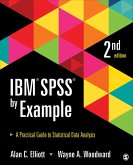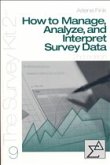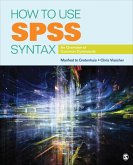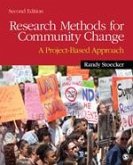Erin Ruel, William E Wagner-Huang, Brian Joseph Gillespie
The Practice of Survey Research
Theory and Applications
Erin Ruel, William E Wagner-Huang, Brian Joseph Gillespie
The Practice of Survey Research
Theory and Applications
- Broschiertes Buch
Andere Kunden interessierten sich auch für
![How to Assess and Interpret Survey Psychometrics How to Assess and Interpret Survey Psychometrics]() Mark S LitwinHow to Assess and Interpret Survey Psychometrics79,99 €
Mark S LitwinHow to Assess and Interpret Survey Psychometrics79,99 €![IBM SPSS by Example IBM SPSS by Example]() Alan C ElliottIBM SPSS by Example80,99 €
Alan C ElliottIBM SPSS by Example80,99 €![How to Manage, Analyze, and Interpret Survey Data How to Manage, Analyze, and Interpret Survey Data]() Arlene G FinkHow to Manage, Analyze, and Interpret Survey Data110,99 €
Arlene G FinkHow to Manage, Analyze, and Interpret Survey Data110,99 €![How to Use SPSS Syntax How to Use SPSS Syntax]() Manfred Te GrotenhuisHow to Use SPSS Syntax49,99 €
Manfred Te GrotenhuisHow to Use SPSS Syntax49,99 €![How to Design Survey Studies How to Design Survey Studies]() Arlene G FinkHow to Design Survey Studies49,99 €
Arlene G FinkHow to Design Survey Studies49,99 €![Research Basics Research Basics]() SpickardResearch Basics162,99 €
SpickardResearch Basics162,99 €![Research Methods for Community Change Research Methods for Community Change]() Randy R StoeckerResearch Methods for Community Change110,99 €
Randy R StoeckerResearch Methods for Community Change110,99 €-
-
-
Produktdetails
- Verlag: Sage Publications
- Seitenzahl: 360
- Erscheinungstermin: 3. Juni 2015
- Englisch
- Abmessung: 228mm x 184mm x 20mm
- Gewicht: 658g
- ISBN-13: 9781452235271
- ISBN-10: 1452235279
- Artikelnr.: 42031708
Hinweis: Dieser Artikel kann nur an eine deutsche Lieferadresse ausgeliefert werden.
- Herstellerkennzeichnung
- Libri GmbH
- Europaallee 1
- 36244 Bad Hersfeld
- gpsr@libri.de
Erin Ruel is associate professor of sociology and director of graduate studies at Georgia State University in Atlanta, GA. She received her PhD in sociology at the University of Illinois at Chicago in 2003. In 2003, Erin took a postdoctoral position at the University of Wisconsin Madison in the Center for Demography of Health and Aging. While there, she continued to hone her survey research skills on the Wisconsin Longitudinal Study. Soon after arriving in Atlanta to take an assistant professor position at Georgia State University (GSU) in 2005, she began the Urban Health Initiative, a longitudinal survey study of public housing residents facing involuntary relocation with GSU colleagues. Erin was principal investigator of the National Institutes of Health study on the health outcomes of relocated public housing residents and co-investigator on two National Science Foundation grants, examining social disorganization and social support for public housing residents. She employs quantitative and mixed methods to examine health disparities and the health consequences of racial residential segregation, neighborhood disadvantage, housing, and socioeconomic status. Ruel has published in numerous journals, including Demography, Social Forces, Social Science Research, Health and Place, Journal of Housing Studies, Cities, Sociology Compass, Journal of Adolescent Health, and Journal of Urban Health.
Part I: Before the Survey
Chapter 1: Introduction to Survey Research
What is survey research?
How do you know if a survey is good?
Surveys about Teachers: Are They Good Teachers?
Applications of Survey Research
Technology and Survey Research
The Ethics of Survey Research
Key Decisions about Survey Research: What's Ahead
Part II: Questionnaire Design
Chapter 2: Types of Surveys
Omnibus Surveys
Administration
Importance of Proper Training of Interviewers
Types of Surveys
Chapter 3: The Survey Instrument
The Cover Letter
The Survey Instrument
Appearance, Formatting, and Design
Chapter 4: Survey Question Construction
Concept Measurement: Traits, Assessments, and Sentiments
Complex Concepts Question Development
Responses to Questions
Measurement Error
Chapter 5: Validity and Reliability
Reliability
Correlation
Types of Reliability and Estimation
Validity
Chapter 6: Pre-testing and Pilot Testing
Pre-testing
Pilot Testing
Pre-test and Pilot Test Limitations
Part III: Implementing a Survey
Chapter 7: Selecting a Sample: Probability Sampling
Sampling Terminology
Sampling Theory
Probability Sampling Techniques
Chapter 8: Non-Probability Sampling and Sampling Hard to Find Populations
Convenience Sampling
Quota Sampling
Purposive Sampling
Sampling Hard to Find Populations
Chapter 9: Improving Response Rates and Retention
Response Rates and Non-response Errors
Non-response Bias
Attrition in Panel Studies
Methods to Increase Participant Contact and Participant Cooperation
Chapter 10: Technologies to Develop and Implement Surveys
Mail Survey Administration
Computer-assisted Interviewing
Post-survey Data Entry and Data Cleaning Technology
Contracting with a Research Center to Conduct the Survey
Chapter 11: Data Collection
The Self-administered Cross-sectional Mailed Survey
The Self-administered Longitudinal Panel Mailed Survey
Interviewer-administered Surveys
Self-administered Web Surveys
Comparing Survey Types
Storage Needs
Part IV: Post-Survey Data Management and Analysis
Chapter 12: Data Entry
Data Entry
Documentation
Chapter 13: Data Cleaning
Simple Cross-sectional Data Cleaning
Cosmetic Cleaning
Skip Patterns
Multiple-response Questions, Other Specify and Open-ended Questions
Cleaning for Diagnostics
Interviewer Effects/Mode Effects
Cleaning Longitudinal Data
The Codebook
Chapter 14: Data Analysis for a Policy Report
Policy Reports
Descriptive Statistics
Analysis for a Policy Report
Summary
The Report Write-up
Chapter 15: More Advanced Data Analysis
Explanatory Research Questions
Journal Article Format
Regression Analysis
Addressing Missing Data
OLS Regressions of the Positive Relocation Scale
Creating Tables for the Journal Article and Writing-up the Results
Chapter 16: Data Archiving
Seeking External Funding for Your Survey Project
Archiving Original and Final Data
Data Format
Archiving and Making Data Publicly Available
Archives
Epilogue
Survey Administration checklist
Survey Design and Organization Checklist
Writing Good Questions Checklist
Piloting or Pre-Testing the Survey Checklist
Choosing a Sample Checklist
Improving Response Rates Checklist
Chapter 1: Introduction to Survey Research
What is survey research?
How do you know if a survey is good?
Surveys about Teachers: Are They Good Teachers?
Applications of Survey Research
Technology and Survey Research
The Ethics of Survey Research
Key Decisions about Survey Research: What's Ahead
Part II: Questionnaire Design
Chapter 2: Types of Surveys
Omnibus Surveys
Administration
Importance of Proper Training of Interviewers
Types of Surveys
Chapter 3: The Survey Instrument
The Cover Letter
The Survey Instrument
Appearance, Formatting, and Design
Chapter 4: Survey Question Construction
Concept Measurement: Traits, Assessments, and Sentiments
Complex Concepts Question Development
Responses to Questions
Measurement Error
Chapter 5: Validity and Reliability
Reliability
Correlation
Types of Reliability and Estimation
Validity
Chapter 6: Pre-testing and Pilot Testing
Pre-testing
Pilot Testing
Pre-test and Pilot Test Limitations
Part III: Implementing a Survey
Chapter 7: Selecting a Sample: Probability Sampling
Sampling Terminology
Sampling Theory
Probability Sampling Techniques
Chapter 8: Non-Probability Sampling and Sampling Hard to Find Populations
Convenience Sampling
Quota Sampling
Purposive Sampling
Sampling Hard to Find Populations
Chapter 9: Improving Response Rates and Retention
Response Rates and Non-response Errors
Non-response Bias
Attrition in Panel Studies
Methods to Increase Participant Contact and Participant Cooperation
Chapter 10: Technologies to Develop and Implement Surveys
Mail Survey Administration
Computer-assisted Interviewing
Post-survey Data Entry and Data Cleaning Technology
Contracting with a Research Center to Conduct the Survey
Chapter 11: Data Collection
The Self-administered Cross-sectional Mailed Survey
The Self-administered Longitudinal Panel Mailed Survey
Interviewer-administered Surveys
Self-administered Web Surveys
Comparing Survey Types
Storage Needs
Part IV: Post-Survey Data Management and Analysis
Chapter 12: Data Entry
Data Entry
Documentation
Chapter 13: Data Cleaning
Simple Cross-sectional Data Cleaning
Cosmetic Cleaning
Skip Patterns
Multiple-response Questions, Other Specify and Open-ended Questions
Cleaning for Diagnostics
Interviewer Effects/Mode Effects
Cleaning Longitudinal Data
The Codebook
Chapter 14: Data Analysis for a Policy Report
Policy Reports
Descriptive Statistics
Analysis for a Policy Report
Summary
The Report Write-up
Chapter 15: More Advanced Data Analysis
Explanatory Research Questions
Journal Article Format
Regression Analysis
Addressing Missing Data
OLS Regressions of the Positive Relocation Scale
Creating Tables for the Journal Article and Writing-up the Results
Chapter 16: Data Archiving
Seeking External Funding for Your Survey Project
Archiving Original and Final Data
Data Format
Archiving and Making Data Publicly Available
Archives
Epilogue
Survey Administration checklist
Survey Design and Organization Checklist
Writing Good Questions Checklist
Piloting or Pre-Testing the Survey Checklist
Choosing a Sample Checklist
Improving Response Rates Checklist
Part I: Before the Survey
Chapter 1: Introduction to Survey Research
What is survey research?
How do you know if a survey is good?
Surveys about Teachers: Are They Good Teachers?
Applications of Survey Research
Technology and Survey Research
The Ethics of Survey Research
Key Decisions about Survey Research: What's Ahead
Part II: Questionnaire Design
Chapter 2: Types of Surveys
Omnibus Surveys
Administration
Importance of Proper Training of Interviewers
Types of Surveys
Chapter 3: The Survey Instrument
The Cover Letter
The Survey Instrument
Appearance, Formatting, and Design
Chapter 4: Survey Question Construction
Concept Measurement: Traits, Assessments, and Sentiments
Complex Concepts Question Development
Responses to Questions
Measurement Error
Chapter 5: Validity and Reliability
Reliability
Correlation
Types of Reliability and Estimation
Validity
Chapter 6: Pre-testing and Pilot Testing
Pre-testing
Pilot Testing
Pre-test and Pilot Test Limitations
Part III: Implementing a Survey
Chapter 7: Selecting a Sample: Probability Sampling
Sampling Terminology
Sampling Theory
Probability Sampling Techniques
Chapter 8: Non-Probability Sampling and Sampling Hard to Find Populations
Convenience Sampling
Quota Sampling
Purposive Sampling
Sampling Hard to Find Populations
Chapter 9: Improving Response Rates and Retention
Response Rates and Non-response Errors
Non-response Bias
Attrition in Panel Studies
Methods to Increase Participant Contact and Participant Cooperation
Chapter 10: Technologies to Develop and Implement Surveys
Mail Survey Administration
Computer-assisted Interviewing
Post-survey Data Entry and Data Cleaning Technology
Contracting with a Research Center to Conduct the Survey
Chapter 11: Data Collection
The Self-administered Cross-sectional Mailed Survey
The Self-administered Longitudinal Panel Mailed Survey
Interviewer-administered Surveys
Self-administered Web Surveys
Comparing Survey Types
Storage Needs
Part IV: Post-Survey Data Management and Analysis
Chapter 12: Data Entry
Data Entry
Documentation
Chapter 13: Data Cleaning
Simple Cross-sectional Data Cleaning
Cosmetic Cleaning
Skip Patterns
Multiple-response Questions, Other Specify and Open-ended Questions
Cleaning for Diagnostics
Interviewer Effects/Mode Effects
Cleaning Longitudinal Data
The Codebook
Chapter 14: Data Analysis for a Policy Report
Policy Reports
Descriptive Statistics
Analysis for a Policy Report
Summary
The Report Write-up
Chapter 15: More Advanced Data Analysis
Explanatory Research Questions
Journal Article Format
Regression Analysis
Addressing Missing Data
OLS Regressions of the Positive Relocation Scale
Creating Tables for the Journal Article and Writing-up the Results
Chapter 16: Data Archiving
Seeking External Funding for Your Survey Project
Archiving Original and Final Data
Data Format
Archiving and Making Data Publicly Available
Archives
Epilogue
Survey Administration checklist
Survey Design and Organization Checklist
Writing Good Questions Checklist
Piloting or Pre-Testing the Survey Checklist
Choosing a Sample Checklist
Improving Response Rates Checklist
Chapter 1: Introduction to Survey Research
What is survey research?
How do you know if a survey is good?
Surveys about Teachers: Are They Good Teachers?
Applications of Survey Research
Technology and Survey Research
The Ethics of Survey Research
Key Decisions about Survey Research: What's Ahead
Part II: Questionnaire Design
Chapter 2: Types of Surveys
Omnibus Surveys
Administration
Importance of Proper Training of Interviewers
Types of Surveys
Chapter 3: The Survey Instrument
The Cover Letter
The Survey Instrument
Appearance, Formatting, and Design
Chapter 4: Survey Question Construction
Concept Measurement: Traits, Assessments, and Sentiments
Complex Concepts Question Development
Responses to Questions
Measurement Error
Chapter 5: Validity and Reliability
Reliability
Correlation
Types of Reliability and Estimation
Validity
Chapter 6: Pre-testing and Pilot Testing
Pre-testing
Pilot Testing
Pre-test and Pilot Test Limitations
Part III: Implementing a Survey
Chapter 7: Selecting a Sample: Probability Sampling
Sampling Terminology
Sampling Theory
Probability Sampling Techniques
Chapter 8: Non-Probability Sampling and Sampling Hard to Find Populations
Convenience Sampling
Quota Sampling
Purposive Sampling
Sampling Hard to Find Populations
Chapter 9: Improving Response Rates and Retention
Response Rates and Non-response Errors
Non-response Bias
Attrition in Panel Studies
Methods to Increase Participant Contact and Participant Cooperation
Chapter 10: Technologies to Develop and Implement Surveys
Mail Survey Administration
Computer-assisted Interviewing
Post-survey Data Entry and Data Cleaning Technology
Contracting with a Research Center to Conduct the Survey
Chapter 11: Data Collection
The Self-administered Cross-sectional Mailed Survey
The Self-administered Longitudinal Panel Mailed Survey
Interviewer-administered Surveys
Self-administered Web Surveys
Comparing Survey Types
Storage Needs
Part IV: Post-Survey Data Management and Analysis
Chapter 12: Data Entry
Data Entry
Documentation
Chapter 13: Data Cleaning
Simple Cross-sectional Data Cleaning
Cosmetic Cleaning
Skip Patterns
Multiple-response Questions, Other Specify and Open-ended Questions
Cleaning for Diagnostics
Interviewer Effects/Mode Effects
Cleaning Longitudinal Data
The Codebook
Chapter 14: Data Analysis for a Policy Report
Policy Reports
Descriptive Statistics
Analysis for a Policy Report
Summary
The Report Write-up
Chapter 15: More Advanced Data Analysis
Explanatory Research Questions
Journal Article Format
Regression Analysis
Addressing Missing Data
OLS Regressions of the Positive Relocation Scale
Creating Tables for the Journal Article and Writing-up the Results
Chapter 16: Data Archiving
Seeking External Funding for Your Survey Project
Archiving Original and Final Data
Data Format
Archiving and Making Data Publicly Available
Archives
Epilogue
Survey Administration checklist
Survey Design and Organization Checklist
Writing Good Questions Checklist
Piloting or Pre-Testing the Survey Checklist
Choosing a Sample Checklist
Improving Response Rates Checklist








